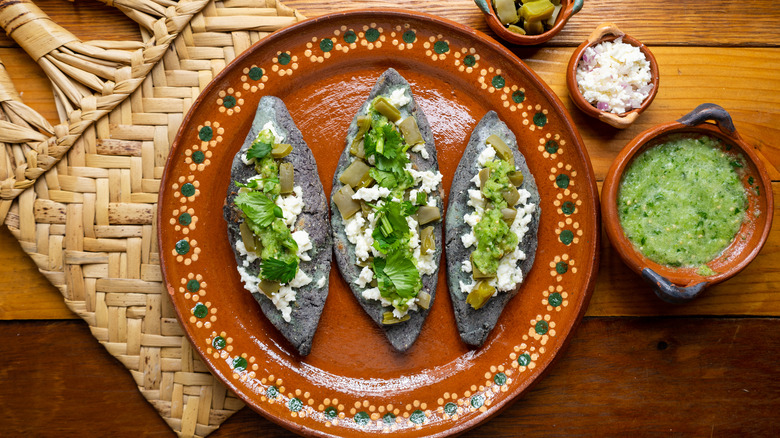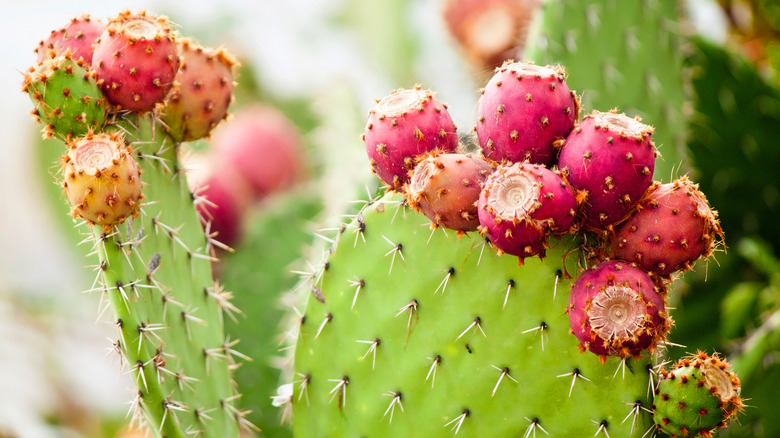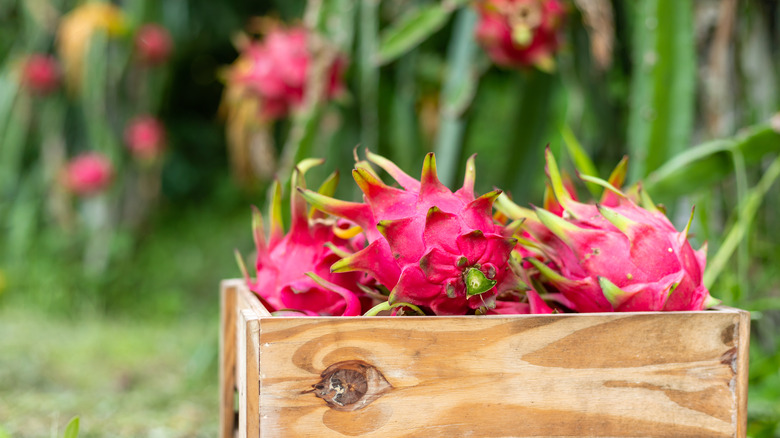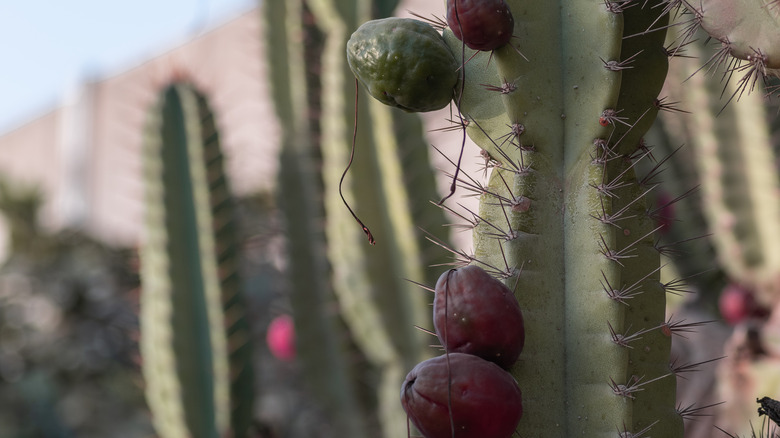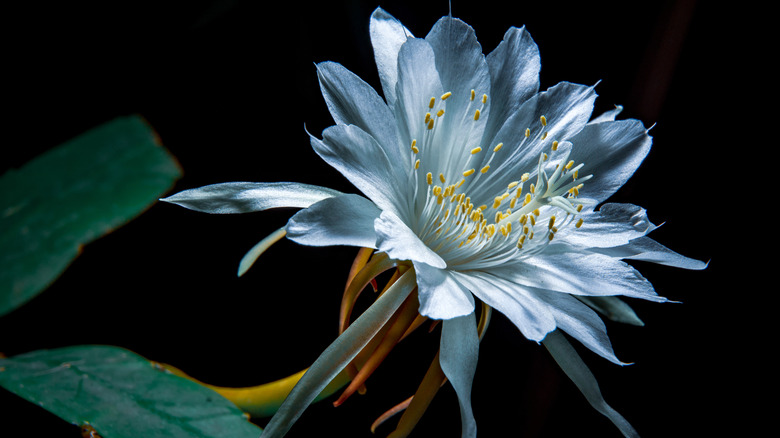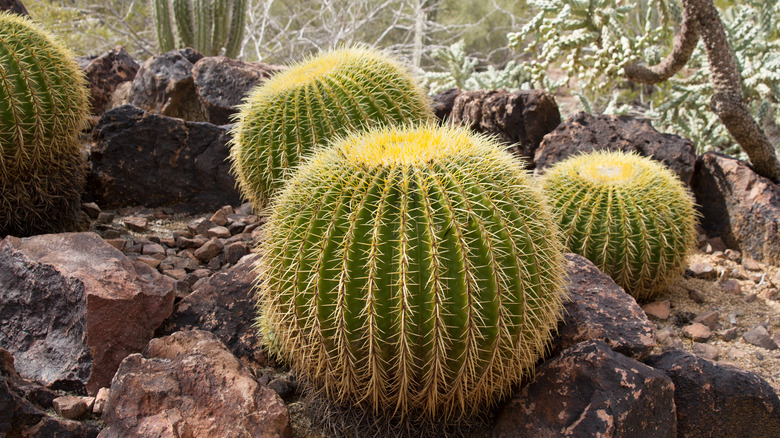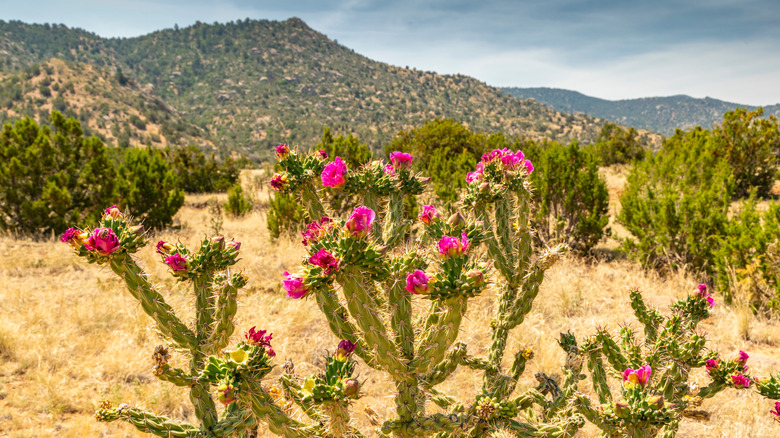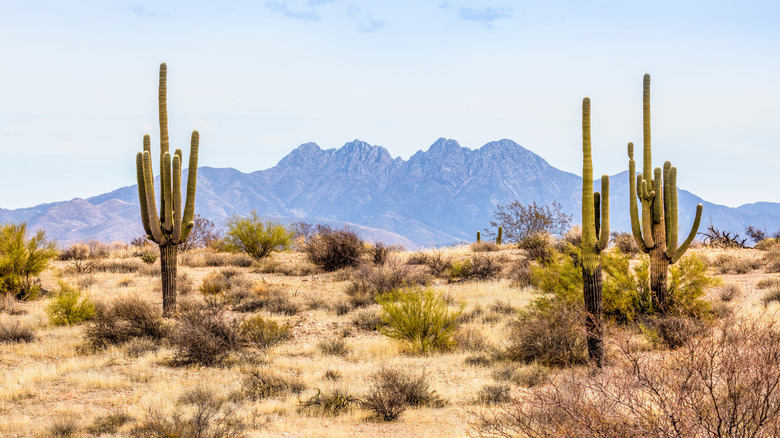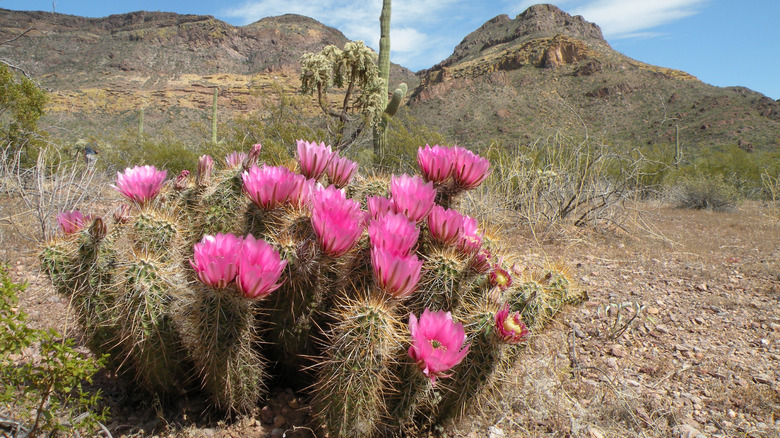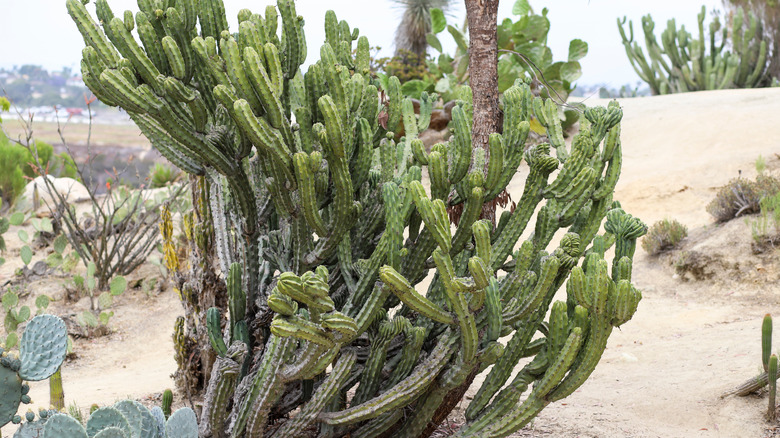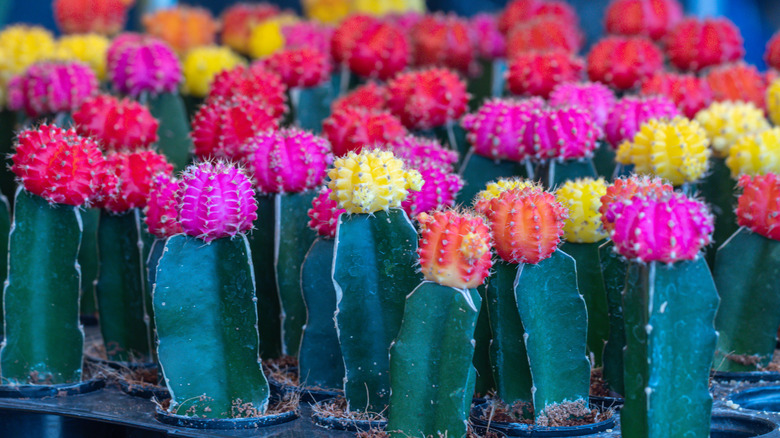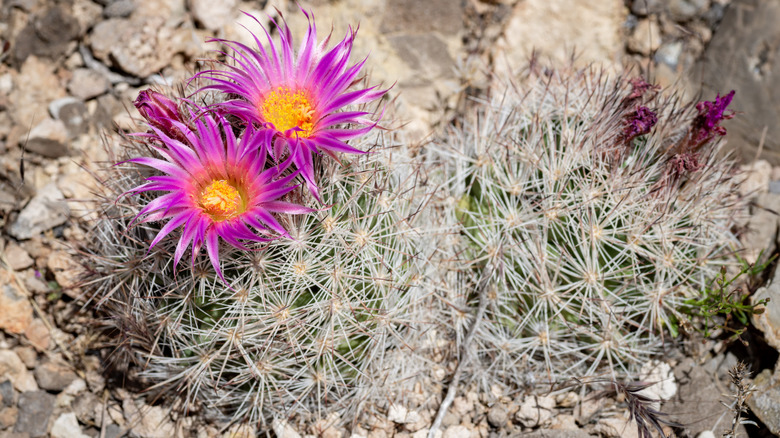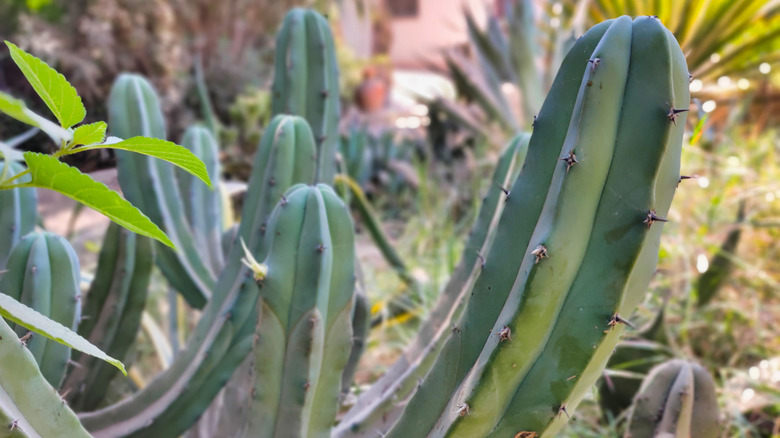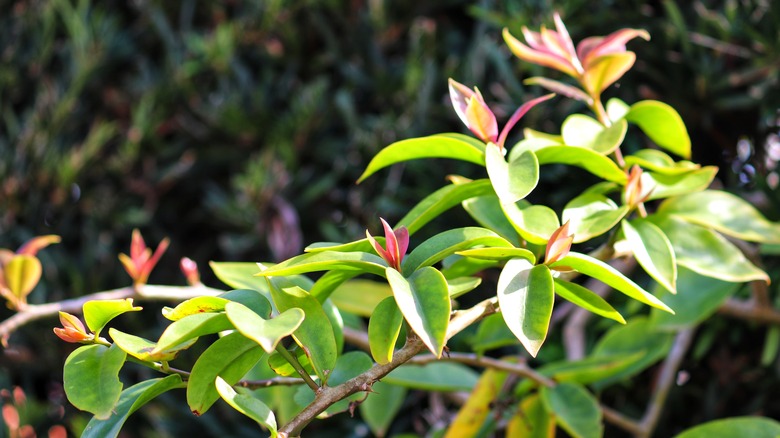13 Types Of Cactus That Are Actually Edible
The cactus is a desert icon that has been used for thousands of years for a multitude of purposes, from making medicines to crafting needles and fish hooks (via National Park Service). Despite their barbs and prickly spines, several cacti are also edible. From fruit and seeds to flowers and paddles, edible cacti have helped sustain populations, making their way into recipe books and survival manuals. Yet, they remain intimidating to many home cooks. Although almost entirely native to the Americas and commonly included in many indigenous and regional cuisines throughout the continents, cactus has not yet made its way into the typical American diet, especially for those living outside of the Southwest.
As the world seeks to diversify its food sources and seek resilient crops to feed a growing population in the face of the climate crisis, many look to indigenous chefs and traditional practices for sustainable solutions. Declared a food of the future by the United Nations, cactus have long been incorporated into Native American, Mexican, Central, and South American cuisines. Drought-resistant, water-storing, nutrient-rich cactus could be a valuable crop for sustaining both human and animal life as temperatures rise and water becomes more scarce (via Journal of Food Science and Technology). This food for the future already has a rich legacy providing resources such as food, medicine, tools, and shelter to indigenous people for centuries, and continues to be an important part of regional cooking practices and traditions.
Prickly pear cactus
When discussing edible cacti, the first type that likely comes to mind is the prickly pear cactus with its wide, flat paddles and bright red fruit. The opuntia, commonly called the prickly pear or Indian fig cactus, can be found broadly throughout the Americas and is popular in the cuisines of Mexico and the American Southwest (via Heritage Garden). Most parts of this cactus are edible, including the fruit, flowers, and paddles, although thick gloves are recommended when harvesting to protect from the needle-like thorns. Prickly pear fruit, sometimes called tuna, turns bright red when ripe with a flavor similar to sweet watermelon and bubble gum. It can be eaten fresh or made into jams, jellies, candies, syrups, and wines once the glochids (small spines) are removed. They can also add a sweet, refreshing element to salads, vinaigrettes, sauces, and desserts.
The paddles of the prickly pear cactus, known as nopales, are a versatile and nutritious ingredient commonly used in cooking across Mexico and the American Southwest. Nopales have a slightly bitter and lightly citrusy taste with an underlying vegetal note similar to asparagus or okra. Depending on the region, nopales can be found fresh or jarred and can be eaten raw, cooked as a filling or topping for tacos and other dishes, chopped into salsas, and roasted, fried, or pickled. The University of Nevada, Reno, notes that nopales are packed with beneficial vitamins and minerals making them a nutrient-rich addition to smoothies, salads, and more.
Dragon fruit
Originating in Central and South America, the dramatic dragon fruit, wrapped in pink and yellow scales with a speckled white center, has become a popular addition to tropical fruit trays, smoothies, salads, juices, and cocktails. Unlike other tropical staples such as guava or mango, this eye-catching fruit actually comes from a cactus. While there are several varieties of dragon fruit, each with its own colors, textures, and flavors, most are free of thorns, have a crunchy bite, and have a sweet taste similar to a kiwi or pear. The white, fleshy interior can be scooped out with a spoon, discarding the skin, which should not be consumed.
Sometimes called pitaya or pitahaya in Mexico and Central America or strawberry pear in Asia, dragon fruit-bearing cactus comes from the genus Hylocereus and can grow rapidly, reaching heights of twenty feet or more (via Agricultural Marketing Resource Center). The highly nutritious fruit has a wide range of culinary uses, from fruit bars to pastries, and the unopened flower buds can also be cooked and eaten like a vegetable. Cleveland Clinic highlights the dragon fruit as an excellent source of fiber and other nutrients, including carotenoids and lycopene, which may reduce cancer risk, as well as magnesium, iron, and vitamin C, which help support critical bodily functions. The widely accessible and highly nutritious dragon fruit is a perfect introduction to those interested in exploring edible cacti.
Peruvian apple cactus
A relative of the dragon fruit, the Peruvian apple cactus bears thorn-less fruit that is purple or red to yellow when ripe with a fleshy white interior dotted with edible seeds. The fruit is smooth and spherical on the outside, distinguishing itself from its scaly dragon fruit cousin. When compared directly to dragon fruit, Tasty Landscape found slight differences in appearance, texture, and taste, with the Peruvian apple fruit having a fluffy, crystalline texture and a mild flavor reminiscent of sugarcane. The fruit of the Peruvian apple cactus can be enjoyed similarly to dragon fruit, eaten raw or as an addition to smoothies and salads.
Due to its dramatic height, often fifteen to thirty feet, and attractive blue to grayish-green hue, the Peruvian apple cactus has become a popular ornamental plant. According to Epic Gardening, the large columnar cactus is easy to care for and a stunning addition to an ornamental or edible garden with its towering, tree-like height; stunning, nocturnal flowers; and bright, sweet fruit.
Queen of the night cactus
Another type of edible cactus is the stunning Queen of the Night, also known as epiphyllum oxypetalum or orchid cactus (via Leafy Palace). Like the dragon fruit and Peruvian apple cactus or pitaya, this variety of cactus produces stunning white flowers that burst into large, fragrant blooms for only a few hours at night, then begin to wilt by the morning. The showy white flowers give this beautiful, night-blooming cactus its name.
This climbing cactus is native to Southern Mexico and South America and has become a prized house plant despite its finicky nature. In the wild, this show-stopping plant might be pollinated by bats or moths but can also be pollinated by hand to produce its mildly sweet, oblong fruit. A pollinated cactus produces purple to red edible fruits with a white, fleshy center speckled with black seeds similar to a dragon fruit or pitaya.
Barrel cactus
With long spines that can be made into fish hooks, needles, toothpicks, and sutures, as well as yellow fruit that resemble small pineapples with edible seeds, this squat, round barrel cactus is a desert survivalists gold mine (via Primitive Lifeways). Despite the barrel cactus' intimidating spikes, the fruit is free of glochids (tiny spines) and can be easily removed from the barrel cactus by carefully grasping and twisting the fruit to detach it from the top of the plant.
The fruit has a tart, lemony taste and can be eaten raw, roasted, or boiled. While the seeds are quite bland raw, the flavor becomes mild and nutty when toasted. The Forager Chef dries and rehydrates barrel cactus fruit for soups and stews, using the mucilage to thicken the broth. The seeds can be eaten raw or dried, toasted, and ground to add to flatbreads, muffin mix, or smoothies.
Cholla cactus
A long-time food source for indigenous peoples across the American Southwest, the cholla cactus is a versatile provider of nutrients via its edible fruit, buds, joints, and stalks. According to the National Park Service, cholla buds are rich in calcium, with a two-tablespoon serving containing as much as a glass of milk. With renewed interest in local, sustainable food sources, workshops in Arizona have begun teaching residents the challenging task of harvesting cholla plants (via Arizona Public Media). Although the joints and stalks are rarely consumed, curious foragers still seek edible cholla fruit and buds.
Cholla cacti are distinguished by their sprawling, shrub-like structure with a woody central stalk and are covered with a thick layer of sharp spines growing in all directions that can detach and stick to the skin (via Plantly). Harvesting the edible parts of this thorny cactus requires courage, long tongs, and some thick leather gloves. The fruit is conical in shape, with the bloom opening from the wider end. Grasp the bud and twist it to separate it from the plant, then use a whisk, metal grate, or torch to remove its spines. Raw cholla fruit and buds contain oxalic acid, an irritant that must be boiled to remove. Boiled cholla fruit and buds have been described to taste reminiscent of strawberries with a pleasant, vegetal note (via Experience Scottsdale). Add boiled buds to salads and salsas, or reduce the fruit to syrup for cocktails.
Saguaro cactus
The towering saguaro cactus is an icon of desert landscapes and an enduring symbol of the American Southwest. The saguaro is a keystone species that has long been an important source of food and shelter for indigenous tribes of the Sonoran Desert, such as the Tohono O'odham, Kimel O'odham, Hia c-ed O'odham, and Seri (via Desert Museum). Saguaro fruit is similar to prickly pear and grows from the crowns of the arms and main stalk. The U.S. Forest Service notes that this type of cactus can live for two hundred years, reaching almost fifty feet tall with a ten-foot circumference!
Generations of Tohono O'odham have harvested saguaro fruits using long poles made of saguaro ribs called kuipad (via Trust for Public Land). The juicy red fruit can be eaten raw or cooked down into a sweet syrup or jelly, while the seeds can be ground into protein-rich flour. Fermented saguaro syrup is transformed into ceremonial wine for a traditional monsoon ritual, an important observance of seasonal cleansing to restore both the land and its people (via Tohonochul). A critical part of the Sonoran ecosystem, the saguaro cactus has been a protected species for nearly a century and requires special permits to harvest (via American Forests). In a PBS NewsHour interview, correspondent Stephanie Sy joined by Tohono O'odham member Tanisha Tucker, discussed the observed changes and growing threats to the iconic saguaro driven by drought and rising temperatures.
Hedgehog cactus
Echinocereus, or hedgehog cactus, are prickly shrub-like cactus found across the American Southwest and northern Mexico with bright pink blooms that produce red, fleshy fruit (via Southwest Desert Flora). The vibrant fruit and buds have been used as a food source for indigenous people of the region, including the Pima, Yavapai, and Apache, and can be eaten raw or boiled. However, intrepid foragers should note that in Arizona and Nevada, all varieties of echinocereus engelmanii are protected or salvage restricted.
The Arizona Native Plant Society describes the fruit as inch-long and circular to egg-shaped with a fleshy, white pulp with a sweet, strawberry flavor. As the fruit reaches maturity, the spines begin to fall off. In addition to being eaten raw or dried, the fruit can be reduced to a sweet jam or jelly. The hedgehog cactus also has medicinal qualities, with the soothing juices of the inner stem used to calm sunburn.
Blue myrtle cactus
Blue myrtle cactus is a fascinating variety that transforms as it matures, starting as a single, star-shaped stalk before growing its first few branches and making its way from a prickly shrub to a towering cactus tree (via GDNC Nursery). The columnar cactus takes its name from its bluish-green color and signature form. Easy to root with a striking appearance, the blue myrtle cactus has become a popular ornamental variety in many parts of the world.
The blooms on the blue myrtle cactus are large and showy flowers that are followed by dark, oval-shaped fruit similar to a grape or blueberry. The Henry Shaw Cactus and Succulent Society describe the taste of the blue myrtle fruit to resemble a plum. In Mexico and Guatemala, the sweet fruits of the blue myrtle cactus are called garambullos. According to the University of Arizona, the berry-like fruit was historically a popular product in Mexican markets until 2003, when trade was restricted to prevent endangering the species.
Moon cactus
The colorful moon cactus is a fascinating plant that is actually not one single cactus species but two different types of cacti that have been grafted together to create this unique specimen (via In Defense of Plants). The scientific name for the brightly-hued top is gymnocalycium mihanovichii which is found naturally in parts of Paraguay and Argentina. The garden shop variety is actually a mutated version of the wild species, which is less vibrant due to its production of chlorophyll which masks the vibrant yellows, reds, and purples seen in the popular house plant. Without chlorophyll, these colorful cacti would not survive beyond seedlings. In order for these vivid cacti to survive, they were grafted onto a host cactus of a different genus, often a hylocereus, to create a striking mutant cactus.
The Arizona-Sonora Desert Museum describes the moon cactus fruit as round and red fruits with scattered bumps of hairs and spines. The small fruit splits open when ripe to reveal a white, juicy pulp with small black seeds similar to a dragon fruit or pitaya.
Beehive cactus
Also known as a spinystar cactus inspired by the bright, star-like flowers that grow from the crown of these small, spiny plants, the beehive cactus is a rare, protected cactus that can be found in many parts of the Western United States appearing as far north as Canada and south into Mexico (via USDA). Other names for varieties of the wide-ranging cactus include the ball cactus, biznaga in Spanish, or scientific monikers such as escobaria or coryphantha. These diminutive cacti typically grow in small clusters that can be difficult to spot when not highlighted by their colorful blooms.
The vibrant yellow or purple flowers give way to brownish, berry-like fruits that Galt Museum describes as sweet, juicy, and reminiscent of kiwi. While the modern-day beehive cactus is most often simply appreciated for its appearance and vivid flowers, the protected cactus has a history as a food source for indigenous peoples.
Escontria cactus
Escontria cactus, sometimes referred to as choitilla or jiotilla, is native to Mexico and grown for its fruit or for agroforestry initiatives like living fences (via Plants for a Future). Geometric, star-shaped, branching stalks are spiked along the edges and grow scaly, brown to purple fruit with a red, fleshy pulp from delicate, pale flowers that bloom at the crown of the branches.
The fruit of the escontria cactus can be eaten raw or juiced and is said to be sweet with a gooseberry-like flavor. Desert Tropicals suggests using the fruit to make jam, ice creams, and drinks. Like other cactus fruit, the fruit of the escontria is believed to be rich in nutrients and cancer-fighting antioxidants. Researchers are also exploring the anticancer potential in the extract of cactus fruits like those from the escontria (via National Library of Medicine). With its sweet edible fruit, potential medicinal properties, and agricultural uses, the escontria is a fascinating and versatile cactus.
Barbados gooseberry cactus
A climbing, leafy cactus, the Barbados gooseberry cactus is a unique plant with a storied history. The Hawaii Invasive Species Council reports that this unusual, intrusive cactus forms dense, thorny thickets that can destroy patches of forest by smothering the trees. Spreading through the islands as an escaped ornamental, the Barbados gooseberry cactus is native to the West Indies and the northern coast of South America. The cactus has fragrant flowers and tart orange berries with inedible black seeds that are deseeded and cooked down into syrups or jams. Although the branches are covered in spines, the fleshy leaves are edible and an excellent source of protein and other nutrients.
In Minas Gerais, Brazil, the leaves of the Barbados gooseberry are stewed into a nutritious dish with a rebellious legacy. For his award-winning television series Parts Unknown, culinary legend Anthony Bourdain visited Minas Gerais to learn about the region's unique cuisine. When gold brought invaders and colonizers to the lush forests of Brazil, the indigenous populations and imported West Africans they enslaved were barred from harvesting the versatile, nutrient-dense cactus. During mass, when the priest uttered the Latin ora pro nobis signaling a long prayer for the Catholic missionaries, the slaves used the diversion to harvest the forbidden leaves. Each May, the Festival do Ora-pro-Nóbis de Sabará celebrates the plant and traditional dishes that include unique ingredients, such as angú, refogado, and pork ribs which combine native produce and European imports with African cooking techniques.
